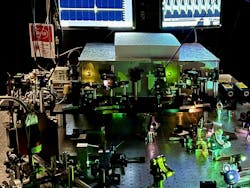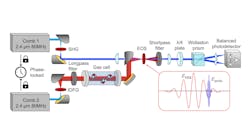Ultrabroadband UV frequency combs show promise for high-res atomic and molecular spectroscopy
An ultrafast laser platform with a million comb lines developed by a team of researchers led by Konstantin Vodopyanov, an optics, photonics, and physics professor at the University of Central Florida’s College of Optics and Photonics, shows promise for enhancing high-resolution atomic and molecular spectroscopy (see video).
Optical frequency combs—essentially light rulers—emit thousands of equally spaced spectral lines. These laser sources measure frequencies with extreme precision by sending photons into a microresonator (small cavity), where they circulate and light is divided into a wide range of frequencies.
“High-resolution broadband UV comb spectroscopy enables unique insights into electronic transitions within atoms and molecules, which makes it invaluable for chemical analysis, photochemistry, atmospheric trace gas sensing, and exoplanet exploration—applications that require simultaneous detection of numerous absorption features,” says Vodopyanov.
Design and discovery
The team’s dual-comb system design for UV spectroscopy involves two mutually coherent 2.4-µm combs. By harnessing periodically poled lithium niobate (PPLN) crystals, two UV bands are generated within both channels: a 6th harmonic comb spans 372 to 410 nm with one million spectrally resolved lines, while a 7th harmonic comb (325 to 342 nm) has approximately 550,000 comb lines.
“This setup enabled us to resolve the UV comb lines with finesse as high as 2,600,” says Vodopyanov.
Vodopyanov and colleagues had already pioneered advanced frequency comb techniques within the mid-infrared and terahertz regions, but the UV range was a new endeavor and the discovery of ultrabroadband UV combs was serendipitous.
“During experiments involving third and fourth harmonic generation within a PPLN crystal to perform ‘3f to 4f interferometry’ for stabilizing our mid-infrared combs based on Cr:ZnS ultrafast lasers at 2.4 µm, we observed the generation of higher harmonics—up to the 7th—and reached the short-wave transmission cutoff of lithium niobate at approximately 320 nm,” Vodopyanov explains.
The team recognized these high-harmonic outputs as broadband UV combs that required a new method to resolve their frequency structure with high spectral precision because it was beyond the capability of existing UV spectrometers.
“We turned to dual-comb spectroscopy, a powerful technique to coherently combine two frequency combs with slightly different line spacings on a single detector to produce interferograms,” says Vodopyanov. “By applying a Fourier transform, the complete spectrum can be reconstructed with exceptional spectral resolution and rapid acquisition.”
Precision spectral lines
By referencing the spectral lines to an atomic clock, the researchers performed highly precise spectroscopic measurements suitable for demanding applications.
As a demonstration, they used the dual-comb spectroscopy system to measure the narrow reflection spectrum of a volume Bragg grating mirror and achieved a resolving power of 10 million, which significantly outperformed existing grating and Fourier spectrometers.
“Our system sets a benchmark for UV comb spectroscopy,” says Vodopyanov. “Given the narrow widths of the comb lines, the spectral resolution can be increased beyond the comb line spacing (80 MHz) by gradually shifting the combs and repeating measurements. PPLN transmission currently limits the UV range to wavelengths above 320 nm.”
FURTHER READING
A. Muraviev, D. Konnov, S. Vasilyev, and K. L. Vodopyanov, Optica, 11, 1486–1489 (2024); doi:10.1364/optica.536971.
Related Article
About the Author
Sally Cole Johnson
Editor in Chief
Sally Cole Johnson, Laser Focus World’s editor in chief, is a science and technology journalist who specializes in physics and semiconductors.


